
(a)
Interpretation:
The product of the reaction between
Concept introduction:
The carbonyl carbon of the acid chloride is highly electrophilic and shows nucleophilic addition-elimination reaction with the nucleophile. In the first step, the nucleophile adds the electron deficient carbonyl carbon; it is known as the nucleophilic addition step. Since the chlorine atom is a good leaving group, it departs from the substrate in a nucleophilic elimination step.
Answer to Problem 21.36P
The product of the given reaction is
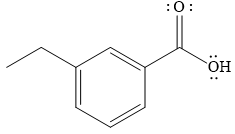
The complete detailed mechanism for the given reaction is
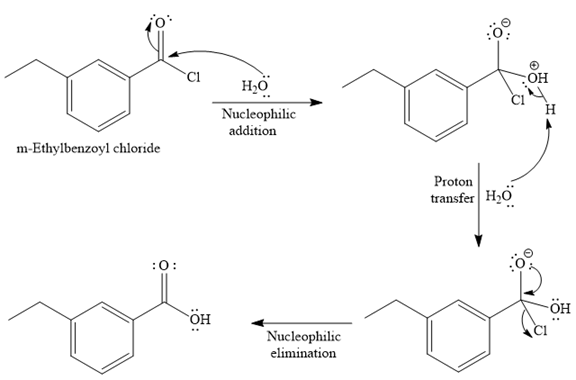
Explanation of Solution
The given reaction is
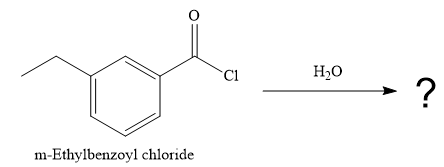
Since water is a nucleophile, it attacks the electron deficient carbonyl carbon of

In the second step, the positive charge of the water’s oxygen is deprotonated, and simultaneously the chlorine anoin departs from the substrate with its bonding pair. Thus, it is called a nucleophilic elimination.

The product of the reaction between
(b)
Interpretation:
The product of the reaction between
Concept introduction:
The carbonyl carbon of the acid chloride is highly electrophilic and shows nucleophilic addition-elimination reaction with the nucleophile. In the first step, the nucleophile adds the electron deficient carbonyl carbon; it is known as the nucleophilic addition step. Since the chlorine atom is a good leaving group, it departs from the substrate in a nucleophilic elimination step.
Answer to Problem 21.36P
The product of the given reaction is

The complete detailed mechanism for the given reaction is
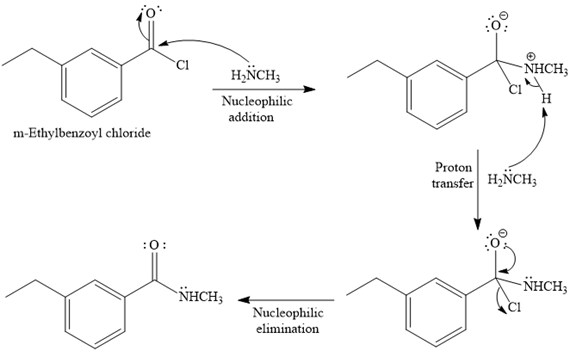
Explanation of Solution
The given reaction is
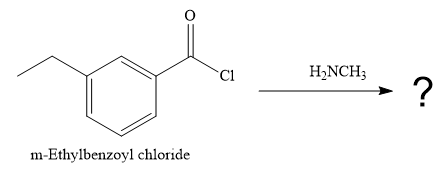
Since methyl

In the second step, the positive charge of the nitrogen atom is deprotonated, and simultaneously chlorine atom departs from the substrate with its bonding pair in a nucleophilic elimination step.

The product of the reaction between
(c)
Interpretation:
The product of the reaction between
Concept introduction:
The carbonyl carbon of the acid chloride is highly electrophilic and shows nucleophilic addition-elimination reaction with the nucleophile. In the first step, the nucleophile adds the electron deficient carbonyl carbon; it is known as the nucleophilic addition step. Since the chlorine atom is a good leaving group, it departs from the substrate in a nucleophilic elimination step.
Answer to Problem 21.36P
The product of the given reaction is
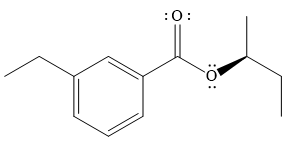
The complete detailed mechanism for the given reaction is
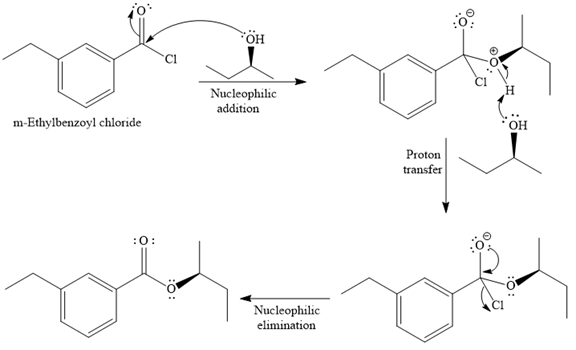
Explanation of Solution
The given reaction is
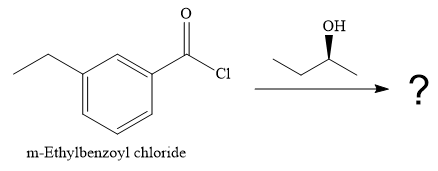
Since an alcohol is a nucleophile, it attacks the electron deficient carbonyl carbon of

In the second step, the positive charge of the alcohol’s oxygen is deprotonated, and simultaneously the chlorine anion departs from the substrate with its bonding pair. Thus, it is called a nucleophilic elimination.
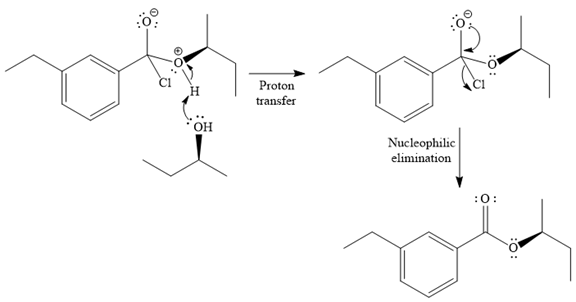
The product of the reaction between
(d)
Interpretation:
The product of the reaction between
Concept introduction:
The carbonyl carbon of the acid chloride is highly electrophilic and shows nucleophilic addition-elimination reaction with the nucleophile. In the first step, the nucleophile adds the electron deficient carbonyl carbon; it is known as the nucleophilic addition step. Since the chlorine atom is a good leaving group, it departs from the substrate in a nucleophilic elimination step.
Answer to Problem 21.36P
No reaction occurs as the positive charge of the oxygen atom is not simply deprotonated.

Explanation of Solution
The given reaction is
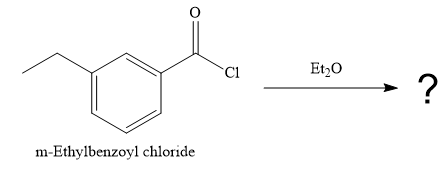
When the lone pair of the oxygen atom attacks the carbonyl carbon, it acquires a positive charge, which does not show deprotonation reaction.

Thus, the given reaction does not occur.

No reaction occurs as the positive charge of the oxygen atom is not simply deprotonated.
Want to see more full solutions like this?
Chapter 21 Solutions
Organic Chemistry: Principles And Mechanisms: Study Guide/solutions Manual (second)
- Identify the compound with the longest carbon - nitrogen bond. O CH3CH2CH=NH O CH3CH2NH2 CH3CH2C=N CH3CH=NCH 3 The length of all the carbon-nitrogen bonds are the samearrow_forwardIdentify any polar covalent bonds in epichlorohydrin with S+ and 8- symbols in the appropriate locations. Choose the correct answer below. Η H's+ 6Η Η Η Η Η Ηδ Η Ο Ο HH +Η Η +Η Η Η -8+ CIarrow_forwardH H:O::::H H H HH H::O:D:D:H HH HH H:O:D:D:H .. HH H:O:D:D:H H H Select the correct Lewis dot structure for the following compound: CH3CH2OHarrow_forward
- Rank the following compounds in order of decreasing boiling point. ннннн -С-С-Н . н-с- ННННН H ΗΤΗ НННН TTTĪ н-с-с-с-с-о-н НННН НН C' Н н-с-с-с-с-н НН || Ш НННН H-C-C-C-C-N-H ННННН IVarrow_forwardRank the following compounds in order of decreasing dipole moment. |>||>||| ||>|||>| |>|||>|| |||>||>| O ||>>||| H F H F H c=c || H c=c F F IIIarrow_forwardchoose the description that best describes the geometry for the following charged species ch3-arrow_forward
- Why isn't the ketone in this compound converted to an acetal or hemiacetal by the alcohol and acid?arrow_forwardWhat is the approximate bond angle around the nitrogen atom? HNH H Harrow_forwardOH 1. NaOCH2CH3 Q 2. CH3CH2Br (1 equiv) H3O+ Select to Draw 1. NaOCH2 CH3 2. CH3Br (1 equiv) heat Select to Edit Select to Drawarrow_forward
- Complete and balance the following half-reaction in acidic solution. Be sure to include the proper phases for all species within the reaction. S₂O₃²⁻(aq) → S₄O₆²⁻(aq)arrow_forwardQ Select to Edit NH3 (CH3)2CHCI (1 equiv) AICI 3 Select to Draw cat. H2SO4 SO3 (1 equiv) HO SOCl2 pyridine Select to Edit >arrow_forwardComplete and balance the following half-reaction in basic solution. Be sure to include the proper phases for all species within the reaction. Zn(s) → Zn(OH)₄²⁻(aq)arrow_forward
 ChemistryChemistryISBN:9781305957404Author:Steven S. Zumdahl, Susan A. Zumdahl, Donald J. DeCostePublisher:Cengage Learning
ChemistryChemistryISBN:9781305957404Author:Steven S. Zumdahl, Susan A. Zumdahl, Donald J. DeCostePublisher:Cengage Learning ChemistryChemistryISBN:9781259911156Author:Raymond Chang Dr., Jason Overby ProfessorPublisher:McGraw-Hill Education
ChemistryChemistryISBN:9781259911156Author:Raymond Chang Dr., Jason Overby ProfessorPublisher:McGraw-Hill Education Principles of Instrumental AnalysisChemistryISBN:9781305577213Author:Douglas A. Skoog, F. James Holler, Stanley R. CrouchPublisher:Cengage Learning
Principles of Instrumental AnalysisChemistryISBN:9781305577213Author:Douglas A. Skoog, F. James Holler, Stanley R. CrouchPublisher:Cengage Learning Organic ChemistryChemistryISBN:9780078021558Author:Janice Gorzynski Smith Dr.Publisher:McGraw-Hill Education
Organic ChemistryChemistryISBN:9780078021558Author:Janice Gorzynski Smith Dr.Publisher:McGraw-Hill Education Chemistry: Principles and ReactionsChemistryISBN:9781305079373Author:William L. Masterton, Cecile N. HurleyPublisher:Cengage Learning
Chemistry: Principles and ReactionsChemistryISBN:9781305079373Author:William L. Masterton, Cecile N. HurleyPublisher:Cengage Learning Elementary Principles of Chemical Processes, Bind...ChemistryISBN:9781118431221Author:Richard M. Felder, Ronald W. Rousseau, Lisa G. BullardPublisher:WILEY
Elementary Principles of Chemical Processes, Bind...ChemistryISBN:9781118431221Author:Richard M. Felder, Ronald W. Rousseau, Lisa G. BullardPublisher:WILEY





